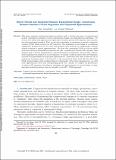Mercer Kernels and Integrated Variance Experimental Design: Connections Between Gaussian Process Regression and Polynomial Approximation
Author(s)
Gorodetsky, Alex Arkady; Marzouk, Youssef M
Download15m1017119.pdf (1.081Mb)
PUBLISHER_POLICY
Publisher Policy
Article is made available in accordance with the publisher's policy and may be subject to US copyright law. Please refer to the publisher's site for terms of use.
Terms of use
Metadata
Show full item recordAbstract
This paper examines experimental design procedures used to develop surrogates of computational models, exploring the interplay between experimental designs and approximation algorithms. We focus on two widely used approximation approaches, Gaussian process (GP) regression and nonintrusive polynomial approximation. First, we introduce algorithms for minimizing a posterior integrated variance (IVAR) design criterion for GP regression. Our formulation treats design as a continuous optimization problem that can be solved with gradient-based methods on complex input domains without resorting to greedy approximations. We show that minimizing IVAR in this way yields point sets with good interpolation properties and that it enables more accurate GP regression than designs based on entropy minimization or mutual information maximization. Second, using a Mercer kernel/eigenfunction perspective on GP regression, we identify conditions under which GP regression coincides with pseudospectral polynomial approximation. Departures from these conditions can be understood as changes either to the kernel or to the experimental design itself. We then show how IVAR-optimal designs, while sacrificing discrete orthogonality of the kernel eigenfunctions, can yield lower approximation error than orthogonalizing point sets. Finally, we compare the performance of adaptive GP regression and adaptive pseudospectral approximation for several classes of target functions, identifying features that are favorable to the GP + IVAR approach. Key words. Gaussian process regression, experimental design, computer experiments, approximation theory,
polynomial approximation, kernel interpolation, uncertainty quantification
Date issued
2016-07Department
Massachusetts Institute of Technology. Department of Aeronautics and AstronauticsJournal
SIAM/ASA Journal on Uncertainty Quantification
Publisher
Society for Industrial & Applied Mathematics (SIAM)
Citation
Gorodetsky, Alex, and Youssef Marzouk. “Mercer Kernels and Integrated Variance Experimental Design: Connections Between Gaussian Process Regression and Polynomial Approximation.” SIAM/ASA Journal on Uncertainty Quantification 4, no. 1 (January 2016): 796–828. © by SIAM and ASA
Version: Final published version
ISSN
2166-2525